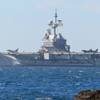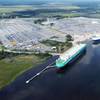Bringing the Capital Construction Fund Program Ashore
On May 5, 2023, the White House announced that the Environmental Protection Agency (EPA) was “taking the next step to invest $3 billion in its Clean Ports Program to fund zero-emission port equipment and technology and to help ports develop climate action plans to reduce air pollutants, improve air quality and public health in neighboring communities, and advance environmental justice.” That “next step” was the issuance of a Request for Information to inform EPA of the availability of zero-emission technologies in the heavy-duty vehicle and port sectors in the agency’s development of funding programs under the Inflation Reduction Act of 2022. EPA has announced that it anticipates this new funding opportunity will become available for application through a notice of funding opportunity (NOFO) released in late winter 2024.
The Infrastructure Investment and Jobs Act (IIJA), also known as the Bipartisan Infrastructure Law, substantially increased funding for the Ports Infrastructure Development Program (PIDP) that is administered by the U.S. Department of Transportation through its Maritime Administration (MARAD). Through the IIJA, $450 million was provided to the PIDP for each of five consecutive fiscal years (FYs) beginning with FY 2022. The Consolidated Appropriations Act, 2022, added more than $230 million to this amount for that fiscal year, and the Consolidated Appropriations Act, 2023, added more than $212 million to the base amount, providing a total of more than $662 million for FY 2023. The NOFOs that have been issued for this increased funding have emphasized the importance of demonstrating that a project for which funding is requested will mitigate the emission of greenhouse gases, including the cargo handling equipment to be purchased for the project.
While funding programs such as those of EPA and MARAD are important in furthering the policy goals they are intended to support, history has shown that the continued and regular authorization and appropriation of funds by Congress for such programs cannot be relied on, with recent developments on Capitol Hill being only the latest example of this. At the same time, it is reasonable to expect that the pressure on ports and marine terminals to achieve the policy objectives that gave rise to these programs will continue and even increase, even if the funding of grant programs does not keep pace.
To help address this situation and other funding needs of ports and marine terminals, in late July of this year, Representatives Mike Ezell (R-Miss.) and Troy Carter (D-La.) introduced in the U.S. House of Representatives H.R. 4993, a bill to extend the Capital Construction Fund (CCF) program administered by MARAD to landside marine facilities.
For those not already familiar with the CCF program, since its creation in the Merchant Marine Act of 1936, it has allowed owners and operators of eligible U.S.-flag vessels to defer federal taxes on income from vessel operations and gains from vessel sales by excluding from taxable income any amounts from such sources that are deposited into a CCF account established through a contract with MARAD. Earnings from the investment of deposits in a CCF account are nontaxable while in the account. Until recently, withdrawals from a CCF account were tax-free only if they were used for the construction or reconstruction in the United States of U.S. flag vessels that are operated in the U.S. foreign, Great Lakes, noncontiguous domestic, or short-sea transportation trades. Even with these geographical restrictions, today there is more than $2.5 billion on deposit in CCF accounts held by more than 140 fundholders who own or operate vessels in those trades. The CCF program is also available to the owners and operators of vessels engaged in the fisheries of the United States, but this part of the CCF program is separately administered by the U.S. Department of Commerce.
Legislation passed in December 2022 removed the geographic trading restrictions so that qualified withdrawals may now be made from a CCF account for the construction or reconstruction of U.S.-flag vessels that engage in the “foreign or domestic trade of the United States,” which would include vessels operated on U.S. inland waterways. This has the potential to benefit the owners and operators of vessels on the inland waterways in a number of ways, several of which have been discussed in this publication and elsewhere. More detailed discussions of the specific possibilities will be possible when MARAD develops the regulations to reflect the expanded CCF program.
As proposed in H.R. 4993, the CCF program would extend to cargo handling equipment and marine terminal operators tax treatment analogous to how the program currently applies it to vessels and their owners and operators. That is, the bill would allow the operator of a marine terminal in the United States to obtain the tax deferral benefits of a CCF account for the purpose of providing replacement, additional, or reconstructed cargo handling equipment at marine terminals in the United States.
The bill defines “marine terminals” to mean wharves, bulkheads, quays, piers, docks, and other berthing locations as well as adjacent storage or other adjacent areas and structures associated with the primary movement of cargo or materials from vessel to shore, or from shore to vessel. These include structures that are devoted to receiving, handling, consolidating, loading, or delivering waterborne shipments and areas devoted to the maintenance of the terminal equipment.
The bill defines “cargo handling equipment” to mean any vehicle or land-based equipment, and the associated marine terminal or port landside infrastructure, used at a marine terminal to lift or move cargo. The cargo handling equipment would need to be either manufactured in the United States or, if manufactured outside the United States, not produced in the United States in sufficient and reasonably available quantities of a satisfactory quality as determined by the marine terminal operator.
The maximum amount deposited in a CCF account in any taxable year would be the sum of (1) that portion of the fundholder’s taxable income for that taxable year attributable to the operation of a marine terminal in the United States, (2) the amount allowable as a depreciation deduction for the taxable year for cargo handling equipment, (3) the net sales or insurance proceeds from the disposition of cargo handling equipment, and (4) the receipts from the investment of amounts held in the fund. The fundholder’s taxable income for the taxable year would be reduced by amounts deposited under the first category. Gain from a transaction described in the third category would be excluded from taxable income if the net proceeds from the transaction are deposited into the fund. Gains or losses from the investment of amounts held in the fund would not be taken into account in determining the fundholder’s taxable income.
Withdrawals from a CCF account would be “qualified” if made to acquire, construct, or reconstruct cargo handling equipment or to pay the principal of indebtedness incurred in the acquisition, construction, or reconstruction of cargo handling equipment. In general, qualified withdrawals would not be subject to tax, but the tax basis of the equipment so acquired would be reduced by the amounts of such qualified withdrawals.
The bill expressly prohibits withdrawals from a CCF account for fully automated cargo handling equipment that is remotely operated or monitored with or without the exercise of human intervention or control if the Secretary of Transportation determines that such equipment would cause a net loss of jobs within a marine terminal. The bill also expressly prohibits withdrawals from a CCF account to purchase cranes manufactured in the People’s Republic of China.
The bill has been referred to the House Committee on Transportation and Infrastructure’s Subcommittee on Coast Guard and Maritime Transportation. As a practical matter, the introduction of the bill will likely serve for now mainly as a way to get a conversation started about the concept of using the CCF program in this way. Articles such as this in other publications and endorsements from industry representatives such as the National Association of Waterfront Employers suggest that the bill is, in fact, serving this purpose. The proposal also offers another example of how a program can further policy goals without being dependent on the vicissitudes of politics on Capitol Hill. The success the program has had for nearly 90 years is evidence of the soundness of this approach.












